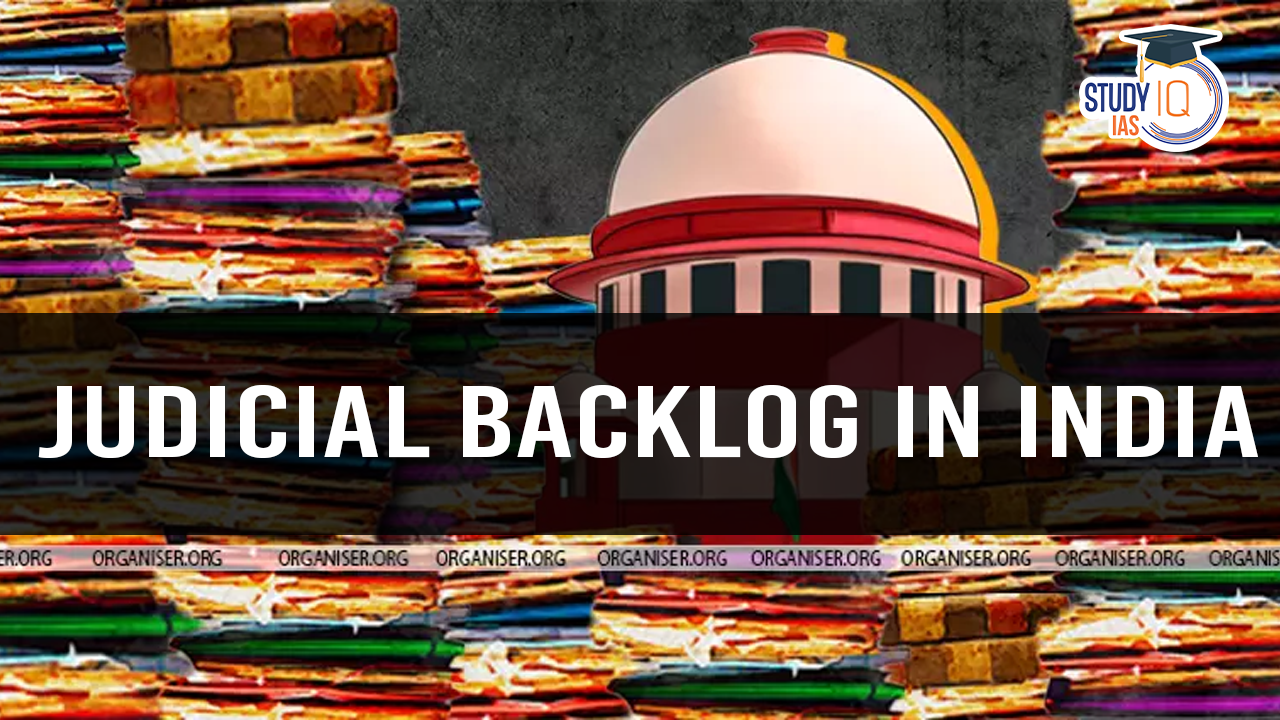Table of Contents
Context: Between Nov 2024 – May 2025, the Supreme Court reduced pendency by 4.83%, achieving a Case Clearance Ratio (CCR) of 106.6%. India’s judicial system faces a significant challenge due to an enormous backlog of cases. This issue affects all levels of the judiciary, from the Supreme Court down to lower courts.
Judicial Backlog in India
- Supreme Court: ~87,000 pending cases (July 2025), of which a majority are at the admission stage.
- High Courts: ~6.2 million pending cases, with states like Uttar Pradesh and West Bengal facing the heaviest load.
- District/Subordinate Courts: ~47 million cases, accounting for nearly 85% of the backlog.
- Long delays: Over 180,000 cases pending for more than 30 years, with the Calcutta High Court alone holding 94% of cases pending over 50 years.
Impact of Judicial Pendency
- Erosion of “Justice Delayed is Justice Denied” – Citizens are denied timely access to justice, weakening constitutional guarantees.
- Prison Overcrowding – Undertrial prisoners form over 75% of India’s prison population, often due to delayed hearings.
- Economic Costs – Business disputes drag on for years, deterring investment and hampering India’s ease of doing business.
- Social Injustice – Vulnerable groups suffer disproportionately, as legal remedies become inaccessible or unaffordable.
- Erosion of Trust – Prolonged delays weaken faith in the judiciary and the rule of law.
- Government Litigation Burden – Since the government is the largest litigant, repeated appeals clog the system further.
How SC’s Success in Case Disposal Can Serve as a Blueprint
- Efficient Case Management: Differentiated Case Management (DCM) identified old, short, and unlisted cases for quick disposal.
- High Courts and District Courts can replicate this by separating routine disputes from complex constitutional matters.
- Tech-Driven Solutions: Use of ICMIS for automatic case allocation reduced human interference.
- AI pilots (SUPACE) helped in curing filing defects and summarising bulky evidence.
- Lower courts can adopt similar AI-assisted screening and e-filing mechanisms.
- Revamped Case Categorisation: SC introduced 48 categories and 182 sub-categories, helping stakeholders identify systemic backlogs.
- Replicable at High Court and district levels for targeted fast-track benches.
- Registrar’s Courts & Defect Clearance: Dedicated Registrar’s benches cleared procedural delays.
- Subordinate courts can create similar “pre-trial benches” to clear defective filings early.
- Bar-Bench Collaboration: Email requests for urgent matters replaced oral mentions, saving judicial time.
- Local courts, too, can enforce uniform listing norms for fairness and efficiency.
- Targeted Disposal Drives: Weekly slots were reserved for long-pending miscellaneous matters.
- District courts could dedicate specific days for petty criminal cases, cheque bounce, or motor vehicle claims, clearing bulk pendency.
Challenges in the Judicial System
- Low Judge-to-Population Ratio: Only about 21 judges per million citizens compared to countries like the U.S., which has around 150 judges per million.
- Adversarial Legal System: Cases undergo multiple interim applications and appeals, prolonging litigation.
- Shortage of Resources:
- Infrastructure deficits: Courtrooms, digital systems, and human resources are inadequate.
- Financial limitations: Limited budget for expanding judicial capacity.
- High Government Litigation: The government is a party in nearly 50% of cases, causing avoidable legal congestion.
Potential Solutions to Reduce Backlog
- Data Governance & Case Classification: Sensible categorization of cases can prevent repetitive legal engagements and speed up disposal.
- Appointing Retired Judges on an Ad-hoc Basis: Helps temporarily reduce backlog, but is not a long-term solution.
- Legal Reforms in High-Volume Litigation Areas: Cheque bouncing and landlord-tenant disputes contribute heavily to the backlog.
- Revising laws to discourage unnecessary litigation (e.g., punitive costs for frivolous cases) can reduce caseloads.
- Government as a Responsible Litigant: The government should settle disputes amicably instead of engaging in prolonged litigation.
- Current efforts show some improvement, but reforms are needed to curb excessive legal battles.
Mediation as a Key Solution
What is Mediation?
- A process where disputing parties meet with a neutral mediator to find a mutually acceptable resolution.
- Confidential, flexible, and voluntary, with no imposed decisions.
Evolution of Mediation in India
- 1990s: Introduced in India as an experimental dispute resolution method.
- 2005: Began gaining traction in courts, becoming an accepted practice.
- Present:
- Judges frequently recommend mediation.
- Thousands of lawyers have become mediators.
- Courts recognise it as a viable dispute resolution mechanism.
Advantages of Mediation
- Faster Resolution: Most cases are resolved in a few sessions, even complex ones.
- Lower Costs: Mediation costs a fraction of litigation for both parties and the judiciary.
- Avoids years of hearings, appeals, and administrative burdens.
- Preservation of Relationships: Unlike litigation, which is adversarial, mediation fosters collaborative problem-solving.
- Helps businesses, families, and individuals maintain relationships.
Implementing Mediation to Reduce Backlog
- Identifying Cases Suitable for Mediation: Large volumes of civil, commercial, and matrimonial disputes can be mediated.
- Assigning Trained Mediators: Courts can direct cases to mediators with experience.
- Reasonable fees should be allocated for mediation services.
- Institutionalizing Mediation: Encourage businesses and the government to adopt mediation before litigation.
- Develop mediation as a full-fledged profession with financial incentives for practitioners.
The judicial backlog in India is a structural challenge that threatens access to justice, economic growth, and public trust. The Supreme Court’s recent success shows that data-driven reforms, differentiated case management, technology adoption, and institutional coordination can significantly improve case disposal. If replicated across High Courts and District Courts, these measures can transform India’s justice delivery system from a sluggish institution into a responsive and accessible people’s court.


 SLAPP Suits: Meaning, Examples, Impact o...
SLAPP Suits: Meaning, Examples, Impact o...
 Finance Commission of India, Articles an...
Finance Commission of India, Articles an...
 High Number of Pending Cases in Supreme ...
High Number of Pending Cases in Supreme ...

























